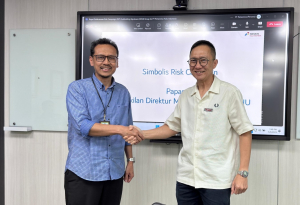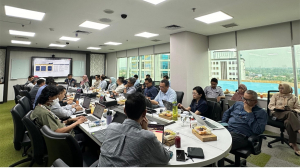21
May

Jakarta– PT Pertamina Hulu Indonesia (PHI) Regional 3 Kalimantan welcomed a visit from the Risk Management Directorate of PT Pertamina Hulu Energi (PHE), the Subholding Upstream (SHU), at the Graha Elnusa Building, Jakarta, on May 6, 2025. This visit was part of a roadshow for the implementation of the Risk Campaign program across all SHU regions and subsidiaries.
This initiative reflects the company’s commitment to strengthening governance and implementing Risk Management across all entities, as well as reinforcing a sustainable risk-aware culture within the SHU environment. The SHU delegation was led by Asep Chaerudin, VP of Risk Strategy & Governance, representing the Director of Risk Management.
In his opening remarks, PHI President Director Sunaryanto expressed appreciation for the visit, recognizing it as a shared commitment to enhancing risk management. He also highlighted several strategic challenges, particularly in managing very mature field assets. These assets not only pose increased operational risks but also expose the company to financial risks such as impairment, occupational and industrial risks, and risks affecting the achievement of the Key Performance Indicator (KPI) for Return on Invested Capital (ROIC), given the high asset value and pressure on the company’s cash flow. Hence, the newly formed Risk Management function, which reports directly to the President Director, is expected to proactively collaborate with all functions in Regional 3 to enhance overall risk resilience and management capability.
VP Risk Strategy & Governance PHE, Asep Chaerudin, explained that the SHU Risk Management Directorate was established in September 2024. It comprises three key functions: Risk Strategy & Governance, Operational Risk Management, and Project Risk Management. The Risk Management Director also serves concurrently as the Chief Risk Officer (CRO).
“The preparation of the Risk Register is the responsibility of the risk owners, as they are most familiar with the risks in their respective functions. The Risk Management function, as the second line of defense, reviews whether the Risk Register is complete or if there are any unidentified or missing risks,” Asep explained, referencing the Three Lines of Defense (or Three Line Model) as outlined in the Ministry of SOEs Regulation No. 2 of 2025.
He further stated that the Risk Campaign initiative is mandated by the Ministry of SOEs Regulation No. 2 of 2023 and serves as an integral part of efforts to enhance the company’s Risk Culture. In addition to the Risk Campaign, other strategic initiatives aimed at strengthening the risk culture include the Risk Management Forum, risk management training, benchmarking activities, and the establishment of a Risk Management KPI as a measure of success.
“The Risk Campaign is designed comprehensively using various communication media, including videos, booklets, broadcasts, banners, interactive quizzes, and social media channels, under the theme Think on Risk. This campaign also serves as an assessment component in the Risk Maturity Assessment, particularly in the dimensions of risk culture and capability,” he added.
During the session, PHI’s management team actively engaged in discussions and Q&A sessions with related functions within the SHU Risk Management Directorate, addressing various potential risks faced by each work unit and exploring strategies for implementing effective and integrated risk management.
As a symbolic gesture to strengthen the risk awareness culture, a 'Think on Risk' themed pin was presented to the President Director of PHI. The 'Think on Risk' tagline represents a collective spirit to build a strong Risk Culture within SHU, enabling the sustainable creation and protection of company value.
The event was also marked by the signing of the Risk Management Treaty by the President Director of PHI, witnessed by the VP of Risk Strategy & Governance, VP of Operational Risk Management, and VP of Project Risk Management of SHU. This treaty serves as a tangible manifestation of top management’s commitment—both the Board of Directors and the Board of Commissioners—to risk management in alignment with the Leadership & Commitment principle within the Risk Management Framework.
The entire series of activities demonstrates PHI's commitment to implementing ESG principles, particularly in the area of Governance, as part of responsible and sustainable upstream oil and gas operational and business governance in support of national energy resilience.

